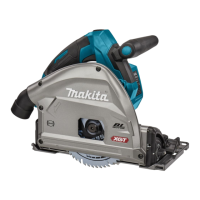17 ENGLISH
OPERATION
This tool is intended to cut wood products. With appro-
priate Makita genuine circular saw blades, following
materials can also be sawed:
• Aluminum products
• Plastic
• Mineral contained plastic
for the correct circular saw blades to be used for the
material to be cut.
CAUTION: When cutting plastic materials,
avoid melting it by overheating of the blade tip.
CAUTION: Be sure to move the tool forward
in a straight line gently. Forcing or twisting the tool
will result in overheating the motor and dangerous
CAUTION: Never approach any part of your
body under the tool base when section cutting,
especially at starting. Doing so may cause seri-
ous personal injuries. The blade is exposed under
the tool base.
CAUTION: Wear dust mask when performing
cutting operation.
NOTE:
as room temperature. Then, the tool can work to its
Section cutting (ordinary sawing)
Fig.25
grip and rear handle. Use both to best grasp the tool.
the circular saw blade. Set the base on the workpiece
switch trigger. Wait until the circular saw blade attains
-
-
the circular saw blade and lead to dangerous kickback
for the circular saw blade to stop and then withdraw
the tool. Realign the tool on new cut line, and start
cut again. Attempt to avoid positioning which exposes
Guide rail
Optional accessory
Place the tool on the rear end of guide rail. Turn two
down the tool to the preset cutting depth and cut the
splinterguard along the full length with a stroke. Now
the edge of the splinterguard corresponds to the cutting
edge.
Fig.26: 1.
When bevel cutting with the guide rail, use the slide
lever to prevent the tool from falling over.
Move the slide lever on the tool base in the direction
of arrow so that it engages the undercut groove in the
guide rail.
Fig.27: 1. Slide lever
Sub base (Guide rule)
Optional accessory
CAUTION: Make sure that the sub base is
securely installed in the correct position before
use.
kickback.
extra-accurate straight cuts. Loosen the clamping
screws and slide the sub base out from the tool then
insert it upside down.
Fig.28: 1. Clamping screw 2. Sub base
the side of the workpiece and secure it in position with
the clamping screws. It also makes repeated cuts of
uniform width possible.
Fig.29: 1. Clamping screw 2. Sub base
Plunge cutting (Cutting-out)
WARNING: To avoid a kickback, be sure to
observe the following instructions.
Fig.30: 1. Rear edge of tool base 2. Fixed stop
When using the tool without guide rail, place the tool on
the workpiece with the rear edge of tool base against a
When using the tool with guide rail, place the tool on the
stop or equivalent which is clamped on the guide rail.
button and turn the tool on and wait until the blade
forward to the desired plunge position.
NOTE: The markings on the side of the blade guard
show the front and rear cutting points of the saw
blade at the maximum cutting depth when using the
guide rail.
Fig.31: 1. Front cutting point 2. Rear cutting point

